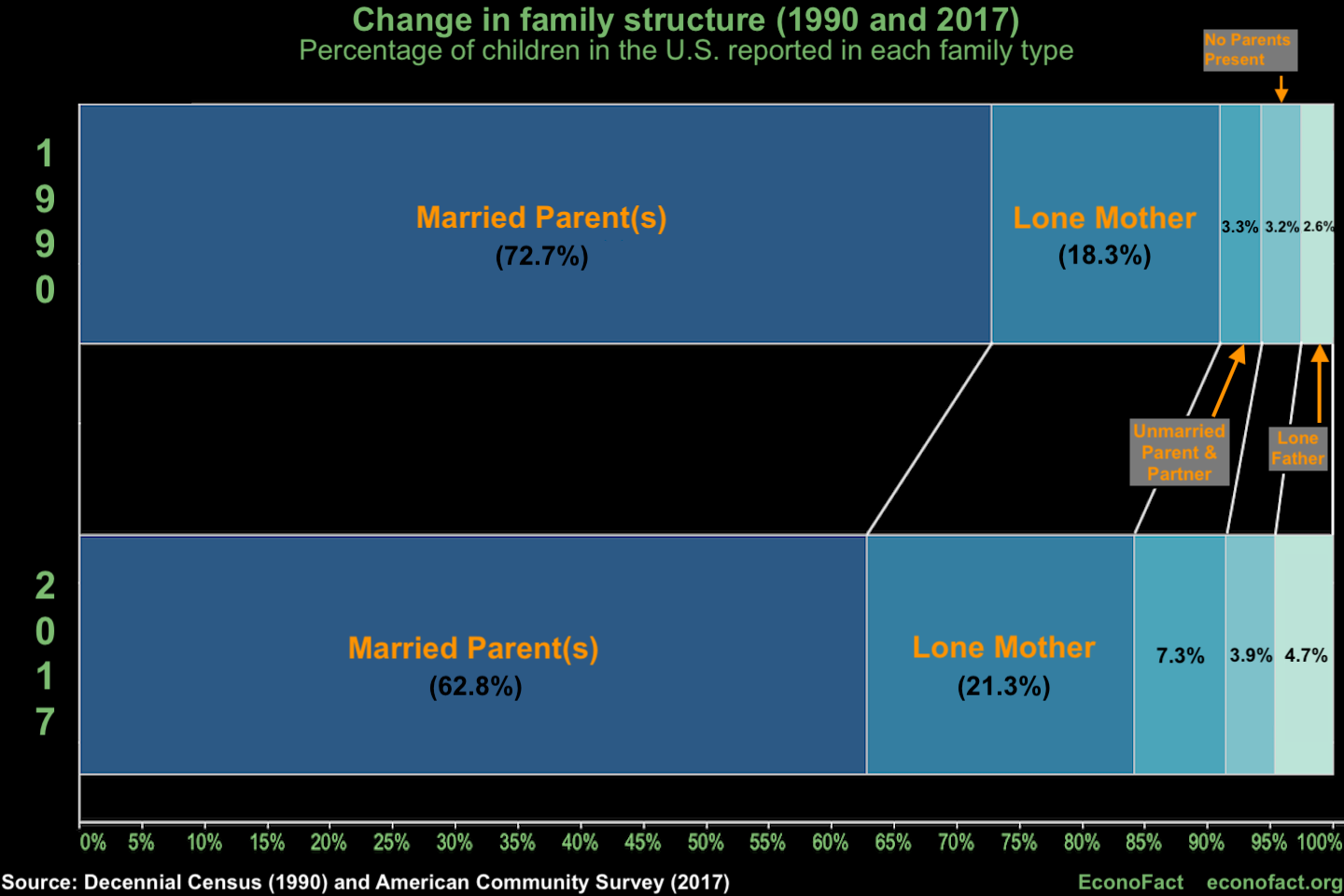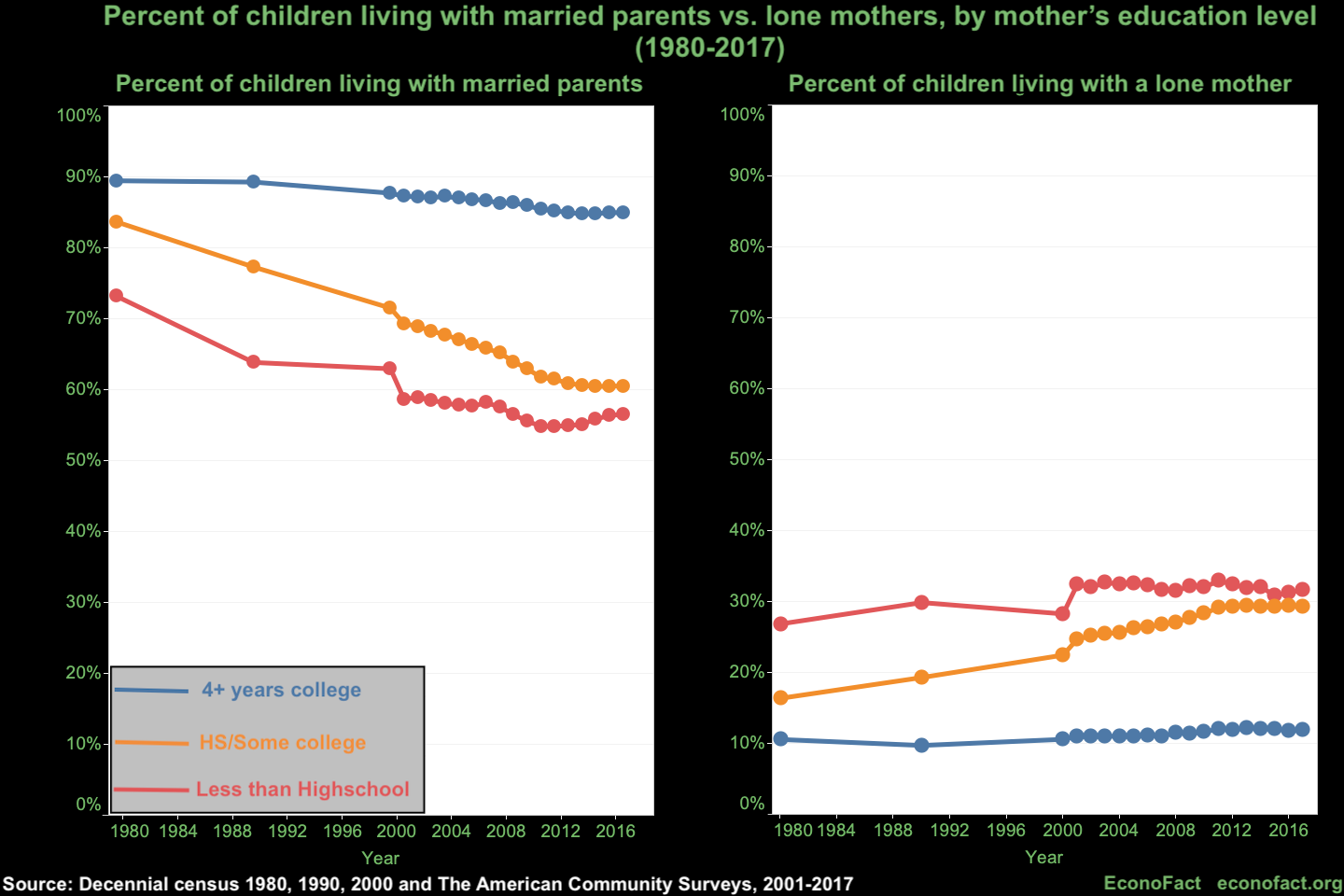Widening Socioeconomic Differences in Children’s Family Structure
University of Maryland
The Issue:
There has been a substantial decline in the share of children in the U.S. living with married parents over recent decades. Importantly, this decline has not been made up for with a rise in the share of children living with unmarried parents; rather, many more children today live with a lone parent than in the recent past. This matters for children’s outcomes and economic security because married-parent homes generally have much higher levels of resources, including higher levels of income, family stability, and parental time, among other benefits. Furthermore, this decline is driven almost entirely by parents with less than a college degree, leading to wide class gaps in the rate at which children are living with two parents.
The Facts:
- Only 63 percent of children in the U.S. today live with married parents (defined as either biological, adopted, or step parents), down from 73 percent in 1990 and 77 in 1980. The next most common type of family structure for children to be living in is with a lone mother: 21 percent of children live with a mother with no likely partner present, up 3 percentage points since 1990. Another 7 percent of children live with an unmarried parent and partner, up 4 percentage points since 1990. Five percent of children live with a lone father, up two percentage points since 1990. Four percent of children now live in households with no parent present. That number has been roughly stable since 1990. While these numbers highlight the decline in the share of children living with married parents in a given year, they actually understate the share of children who will spend at least part of their childhood without married parents given family instability (see here).

- There has been a dramatic widening in the rate at which children are being raised by married parents across groups defined by mother’s education. The decline in the share of children living with married parents over the past four decades has been concentrated among parents with a high school degree or some college (see top chart). Children of mothers with four-years of college (32 percent of kids in 2017) are still being raised predominantly by married parents. In 2017, 85 percent of the children of mothers with four-years of college were being raised by married parents, a decline of only 4 percentage points from the 89 percent in both 1990 and 1980. In contrast, only 60 percent of children of mothers with a high school degree or some college (50 percent of kids in 2017) are living with married parents. This reflects a large decline from 77 percent in 1990 and 84 percent in 1980. More of the change in this group is accounted for by a rise in the share of children living with a mother only – up to 29 percent in 2017 – as compared to children living with a cohabiting unmarried parent and partner, which was 10 percent in 2017. The share of children of mothers with less than a high school degree (10 percent of kids in 2017) who are living with married parents fell 9 percentage points from 1980 to 1990 -- 73 percent to 64 percent -- and experienced a less rapid decline since then, reaching 57 percent in 2017.
- There are large gaps in the share of children living with married parents across racial and ethnic groups, even within education groups. Non-Hispanic White and Asian children are significantly more likely to live with married parents, as compared to Hispanic and black children. In 2017, 73 percent of white non-Hispanic children and 84 percent of Asian children lived with married parents, as compared to 57 percent of Hispanic children and 33 percent of black non-Hispanic children. (These groups constitute 51, 5, 23, and 13 percent of all children, respectively.) In 2017, among children of mothers with four years of college, the share living with married parents was 89 percent among white non-Hispanics, 93 percent among Asians, 77 percent among Hispanics, and 61 percent among black non-Hispanics. Among children with mothers with a high school degree or some college, the share living with married parents was 71 percent among white non-Hispanics, 81 percent among Asians, 59 percent among Hispanics, and 32 percent among black non-Hispanics. Among children with mothers with less than a high school degree, the share living with married parents was 60 percent among white non-Hispanics, 83 percent among Asians, 61 percent among Hispanics, and 22 percent among black non-Hispanics.
- These trends and gaps matter because research has shown that on average, children from married-parent homes benefit from the extra resources that a married-parent home offers relative to other types of household arrangements. Conditional on other family and parental characteristics, children who grow up with an unmarried mother have lower levels of educational attainment and higher levels of teen childbearing, among other outcome differences (e.g., McLanahan and Sandefur, 1994; McLanahan and Sandefur, 1997; Hoffman, Foster, and Furstenberg, 1993; Amato 2005). As adults, they have lower levels of employment, lower levels of income, higher rates of non-marital parenting, and higher rates of incarceration (e.g., Hill, Holzer, and Chen, 2009; DeLeire and Lopoo, 2014; Lehrman, Price, and Wilcox, 2017). Though existing studies cannot precisely isolate the causal effect of family structure from potentially unobservable characteristics of the parents or family, the documented strength of the association between family structure and children’s outcomes, controlling for a myriad of observable factors, is strongly suggestive of a causal relationship. These differences are consistent with the fact that married parent homes tend to have more resources than other family structures, and parental resources matter for children’s outcomes.
- Gaps in children’s outcomes between those with married and unmarried mothers – what we might call a “marriage premium for children” – depend on the resources the mother has herself, the resources her partner would bring to the family, and the ways in which children’s outcomes are affected by parental resources. The largest gaps in high school completion and poverty avoidance for children of married versus unmarried mothers are for children of mothers in their mid-20s and mothers with a high school degree, according to my analysis of data from the Panel Study of Income Dynamics (PSID) conducted with Phillip Levine, of Wellesley College. These are precisely the groups of mothers among whom marriage rates have declined the most rapidly. We also observe differences in the rate of college completion among the children of older and more educated mothers. This is consistent with the fact that children from very highly resourced homes are generally much more likely to obtain a college degree. Our analysis of PSID data reveals that income differences only partially explain these gaps.
- There is evidence that boys’ behavioral outcomes are especially responsive to family structure. Two recent studies by economists show that boys suffer more than girls do when they are raised in a single-mother home. The gender gap in behavioral outcomes (which favors girls) is larger among siblings being raised in single-mother homes, as compared to married-parent homes. One of these studies concludes that the gender gap among black children is larger than among white children in substantial part because black children are more likely to be raised in single-mother, economically disadvantaged homes.
What this Means:
The decline in the share of children being raised by married parents raises important concerns about the trends in children’s economic well-being. In addition, the wide socioeconomic and racial/ethnic gaps in this share raise concerns about socioeconomic and racial/ethnic gaps in economic outcomes for children. While an obvious implication might be that more needs to be done to promote and support married-parent households, the evidence on what types of policies or programs might do so is thin (see, for example, here and here). Perhaps a more fruitful area of focus would be on strengthening families and parental ties, regardless of marital status, so that children who are not being raised in married-parent homes are more likely to experience the types of benefits that this household arrangement tends to bring in terms of greater family resources and family stability.
Like what you’re reading? Subscribe to EconoFact Premium for exclusive additional content, and invitations to Q&A’s with leading economists.

